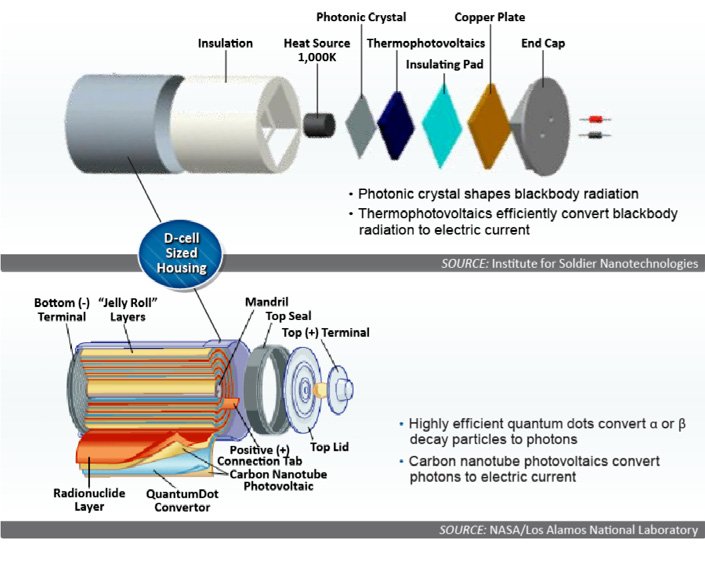Two notional concept for “nuclear batteries were shown in a Defense Science Board report:
The upper concept shows something of a conventional radioistotope thermionic generator, but in small scale. Within it is a 1-cubic centimeter chunk of material infused with alpha and/or beta emitter; the radiation is emitted and absorbed within the chunk, raising the temperature to 1000 Kelvin. A “photonic crystal” captures the blackbody radiation (which in this case would be well into the visible at that temperature) and deposits it onto a thermophotovoltaic cell, where it is converted to electricity. The insulating shell keeps the exterior temperature to about 25 degrees C.
The lower design uses a “jelly roll” configuration with thin flat sheets of alpha and/or beta emitter sandwiched between a sheet of quantum dots, which directly converts the radiation to electricity.
Both designs seem to be made for the same requirements, would produce one to five watts for several years. The radioactive material would be americium or plutonium-238. Pu-238 is a strong alpha emitter, and produced about 0.39 of a watt per gram, so several dozen grams might be needed, depending on efficiency. The only real use for Pu-238 is radioisotope thermionic generators, used on spacecraft; these nuclear batteries would be quite similar. The sad thing is that the US stopped producing Pu-238 in 1988; we now buy it from Russia… but even they have stopped producing it. NASA and the DoE are trying to restore production at a rate of 1.5 kilos or so per year. Since these “nuclear D-cells” are specifically for military applications, restoring manufacturing capability would seem to be needed as a single D-cell would consume maybe 1% of the annual NASA/DoE production.
Americium-241 produces 0.12 watts/gram, substantially less than Pu-238. More importantly, it’s also a neutron emitter, which is obviously bad news for the guy carrying a dozen of these batteries on his belt to power his GPS system, radio and phased plasma rifle in the 40 Watt range.
